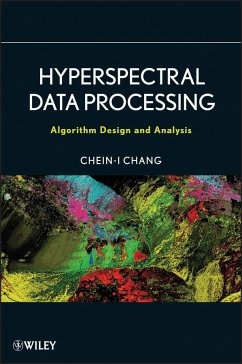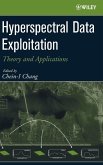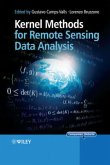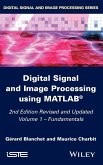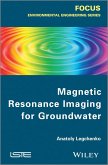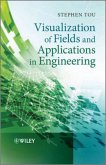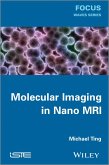- Gebundenes Buch
- Merkliste
- Auf die Merkliste
- Bewerten Bewerten
- Teilen
- Produkt teilen
- Produkterinnerung
- Produkterinnerung
This book is intended to be a sequel to the author's previous work, Hyperspectral Imaging: Techniques for Spectral Detection and Classification. It is comprised of five major parts and covers a wealth of information, including: a discussion of OSP, FPGA designs for OSP and CEM, Kalman filter-based linear unmixing, least squares fully constrained linear mixture analysis, interference rejection for linear unmixing, signal-composed interference-annihilated theory, techniques for linear unmixing, spectral coding, and more.
Hyperspectral Data Processing: Algorithm Design and Analysis is a…mehr
Andere Kunden interessierten sich auch für
![Hyperspectral Data Exploitation Hyperspectral Data Exploitation]() Chein-I Chang (ed.)Hyperspectral Data Exploitation191,99 €
Chein-I Chang (ed.)Hyperspectral Data Exploitation191,99 €![Kernel Methods for Remote Sensing Data Analysis Kernel Methods for Remote Sensing Data Analysis]() Kernel Methods for Remote Sensing Data Analysis160,99 €
Kernel Methods for Remote Sensing Data Analysis160,99 €![Techniques and Applications of Hyperspectral Image Analysis Techniques and Applications of Hyperspectral Image Analysis]() Hans Grahn (ed.) / Paul GeladiTechniques and Applications of Hyperspectral Image Analysis208,99 €
Hans Grahn (ed.) / Paul GeladiTechniques and Applications of Hyperspectral Image Analysis208,99 €![Digital Signal and Image Processing Using Matlab, Volume 1 Digital Signal and Image Processing Using Matlab, Volume 1]() Gérard BlanchetDigital Signal and Image Processing Using Matlab, Volume 1191,99 €
Gérard BlanchetDigital Signal and Image Processing Using Matlab, Volume 1191,99 €![Magnetic Resonance Imaging for Groundwater Magnetic Resonance Imaging for Groundwater]() Anatoly LegtchenkoMagnetic Resonance Imaging for Groundwater164,99 €
Anatoly LegtchenkoMagnetic Resonance Imaging for Groundwater164,99 €![Visualization of Fields and Applications in Engineering Visualization of Fields and Applications in Engineering]() Stephen TouVisualization of Fields and Applications in Engineering125,99 €
Stephen TouVisualization of Fields and Applications in Engineering125,99 €![Molecular Imaging in Nano MRI Molecular Imaging in Nano MRI]() Michael TingMolecular Imaging in Nano MRI164,99 €
Michael TingMolecular Imaging in Nano MRI164,99 €-
-
-
This book is intended to be a sequel to the author's previous work, Hyperspectral Imaging: Techniques for Spectral Detection and Classification. It is comprised of five major parts and covers a wealth of information, including: a discussion of OSP, FPGA designs for OSP and CEM, Kalman filter-based linear unmixing, least squares fully constrained linear mixture analysis, interference rejection for linear unmixing, signal-composed interference-annihilated theory, techniques for linear unmixing, spectral coding, and more.
Hyperspectral Data Processing: Algorithm Design and Analysis is a culmination of the research conducted in the Remote Sensing Signal and Image Processing Laboratory (RSSIPL) at the University of Maryland, Baltimore County. Specifically, it treats hyperspectral image processing and hyperspectral signal processing as separate subjects in two different categories. Most materials covered in this book can be used in conjunction with the author's first book, Hyperspectral Imaging: Techniques for Spectral Detection and Classification, without much overlap.
Many results in this book are either new or have not been explored, presented, or published in the public domain. These include various aspects of endmember extraction, unsupervised linear spectral mixture analysis, hyperspectral information compression, hyperspectral signal coding and characterization, as well as applications to conceal target detection, multispectral imaging, and magnetic resonance imaging. Hyperspectral Data Processing contains eight major sections:
Part I: provides fundamentals of hyperspectral data processing
Part II: offers various algorithm designs for endmember extraction
Part III: derives theory for supervised linear spectral mixture analysis
Part IV: designs unsupervised methods for hyperspectral image analysis
Part V: explores new concepts on hyperspectral information compression
Parts VI & VII: develops techniques for hyperspectral signal coding and characterization
Part VIII: presents applications in multispectral imaging and magnetic resonance imaging
Hyperspectral Data Processing compiles an algorithm compendium with MATLAB codes in an appendix to help readers implement many important algorithms developed in this book and write their own program codes without relying on software packages.
Hyperspectral Data Processing is a valuable reference for those who have been involved with hyperspectral imaging and its techniques, as well those who are new to the subject.
Hyperspectral Data Processing: Algorithm Design and Analysis is a culmination of the research conducted in the Remote Sensing Signal and Image Processing Laboratory (RSSIPL) at the University of Maryland, Baltimore County. Specifically, it treats hyperspectral image processing and hyperspectral signal processing as separate subjects in two different categories. Most materials covered in this book can be used in conjunction with the author's first book, Hyperspectral Imaging: Techniques for Spectral Detection and Classification, without much overlap.
Many results in this book are either new or have not been explored, presented, or published in the public domain. These include various aspects of endmember extraction, unsupervised linear spectral mixture analysis, hyperspectral information compression, hyperspectral signal coding and characterization, as well as applications to conceal target detection, multispectral imaging, and magnetic resonance imaging. Hyperspectral Data Processing contains eight major sections:
Part I: provides fundamentals of hyperspectral data processing
Part II: offers various algorithm designs for endmember extraction
Part III: derives theory for supervised linear spectral mixture analysis
Part IV: designs unsupervised methods for hyperspectral image analysis
Part V: explores new concepts on hyperspectral information compression
Parts VI & VII: develops techniques for hyperspectral signal coding and characterization
Part VIII: presents applications in multispectral imaging and magnetic resonance imaging
Hyperspectral Data Processing compiles an algorithm compendium with MATLAB codes in an appendix to help readers implement many important algorithms developed in this book and write their own program codes without relying on software packages.
Hyperspectral Data Processing is a valuable reference for those who have been involved with hyperspectral imaging and its techniques, as well those who are new to the subject.
Produktdetails
- Produktdetails
- Verlag: Wiley & Sons
- 1. Auflage
- Seitenzahl: 1168
- Erscheinungstermin: 8. April 2013
- Englisch
- Abmessung: 257mm x 185mm x 58mm
- Gewicht: 2060g
- ISBN-13: 9780471690566
- ISBN-10: 0471690562
- Artikelnr.: 32734426
- Herstellerkennzeichnung
- Libri GmbH
- Europaallee 1
- 36244 Bad Hersfeld
- gpsr@libri.de
- Verlag: Wiley & Sons
- 1. Auflage
- Seitenzahl: 1168
- Erscheinungstermin: 8. April 2013
- Englisch
- Abmessung: 257mm x 185mm x 58mm
- Gewicht: 2060g
- ISBN-13: 9780471690566
- ISBN-10: 0471690562
- Artikelnr.: 32734426
- Herstellerkennzeichnung
- Libri GmbH
- Europaallee 1
- 36244 Bad Hersfeld
- gpsr@libri.de
CHEIN-I CHANG, PhD, is a Professor in the Department of Computer Science and Electrical Engineering at the University of Maryland, Baltimore County. He established the Remote Sensing Signal and Image Processing Laboratory and conducts research in designing and developing signal processing algorithms for hyperspectral imaging, medical imaging, and documentation analysis. A Fellow of IEEE and SPIE, Dr. Chang has published over 125 refereed journal articles, including more than forty papers in the IEEE Transaction on Geoscience and Remote Sensing. In addition to authoring Hyperspectral Imaging: Techniques for Spectral Detection and Classification , as well as editing two books, Hyperspectral Data Exploitation: Theory and Applications and Recent Advances in Hyperspectral Signal and Imaging Processing and co-editing one book, High Performance Computing in Remote Sensing, he holds five patents and has several pending.
Preface xxiii
1 Overview and Introduction 1
1.1 Overview 2
1.2 Issues of Multispectral and Hyperspectral Imageries 3
1.3 Divergence of Hyperspectral Imagery from Multispectral Imagery 4
1.4 Scope of This Book 7
1.5 Book's Organization 10
1.6 Laboratory Data to be Used in This Book 19
1.7 Real Hyperspectral Images to be Used in this Book 20
1.8 Notations and Terminologies to be Used in this Book 29
I: Preliminaries 31
2 Fundamentals of Subsample and Mixed Sample Analyses 33
2.1 Introduction 33
2.2 Subsample Analysis 35
2.3 Mixed Sample Analysis 45
2.4 Kernel-Based Classification 57
2.5 Conclusions 60
3 Three-dimensional Receiver Operating Characteristics (3d Roc) Analysis 63
3.1 Introduction 63
3.2 Neyman-Pearson Detection Problem Formulation 65
3.3 ROC Analysis 67
3.4 3D ROC Analysis 69
3.5 Real Data-Based ROC Analysis 72
3.6 Examples 78
3.7 Conclusions 99
4 Design of Synthetic Image Experiments 101
4.1 Introduction 102
4.2 Simulation of Targets of Interest 103
4.3 Six Scenarios of Synthetic Images 104
4.4 Applications 112
4.5 Conclusions 123
5 Virtual Dimensionality of Hyperspectral Data 124
5.1 Introduction 124
5.2 Reinterpretation of VD 126
5.3 VD Determined by Data Characterization-Driven Criteria 126
5.4 VD Determined by Data Representation-Driven Criteria 140
5.5 Synthetic Image Experiments 144
5.6 VD Estimated for Real Hyperspectral Images 155
5.7 Conclusions 163
6 Data Dimensionality Reduction 168
6.1 Introduction 168
6.2 Dimensionality Reduction by Second-Order Statistics-Based Component
Analysis Transforms 170
6.3 Dimensionality Reduction by High-Order Statistics-Based Components
Analysis Transforms 179
6.4 Dimensionality Reduction by Infinite-Order Statistics-Based Components
Analysis Transforms 184
6.5 Dimensionality Reduction by Projection Pursuit-Based Components
Analysis Transforms 190
6.6 Dimensionality Reduction by Feature Extraction-Based Transforms 195
6.7 Dimensionality Reduction by Band Selection 196
6.8 Constrained Band Selection 197
6.9 Conclusions 198
II: Endmember Extraction 201
7 Simultaneous Endmember Extraction Algorithms (SM-EEAs) 207
7.1 Introduction 208
7.2 Convex Geometry-Based Endmember Extraction 209
7.3 Second-Order Statistics-Based Endmember Extraction 228
7.4 Automated Morphological Endmember Extraction (AMEE) 230
7.5 Experiments 231
7.6 Conclusions 239
8 Sequential Endmember Extraction Algorithms (SQ-EEAs) 241
8.1 Introduction 241
8.2 Successive N-FINDR (SC N-FINDR) 244
8.3 Simplex Growing Algorithm (SGA) 244
8.4 Vertex Component Analysis (VCA) 247
8.5 Linear Spectral Mixture Analysis-Based SQ-EEAs 248
8.6 High-Order Statistics-Based SQ-EEAS 252
8.7 Experiments 254
8.8 Conclusions 262
9 Initialization-driven Endmember Extraction Algorithms (ID-EEAs) 265
9.1 Introduction 265
9.2 Initialization Issues 266
9.3 Initialization-Driven EEAs 271
9.4 Experiments 278
9.5 Conclusions 283
10 Random Endmember Extraction Algorithms (REEAs) 287
10.1 Introduction 287
10.2 Random PPI (RPPI) 288
10.3 Random VCA (RVCA) 290
10.4 Random N-FINDR (RN-FINDR) 290
10.5 Random SGA (RSGA) 292
10.6 Random ICA-Based EEA (RICA-EEA) 292
10.7 Synthetic Image Experiments 293
10.8 Real Image Experiments 305
10.9 Conclusions 313
11 Exploration on Relationships Among Endmember Extraction Algorithms 316
11.1 Introduction 316
11.2 Orthogonal Projection-Based EEAs 318
11.3 Comparative Study and Analysis Between SGA and VCA 330
11.4 Does an Endmember Set Really Yield Maximum Simplex Volume? 339
11.5 Impact of Dimensionality Reduction on EEAs 344
11.6 Conclusions 348
III: Supervised Linear Hyperspectral Mixture Analysis 351
12 Orthogonal Subspace Projection Revisited 355
12.1 Introduction 355
12.2 Three Perspectives to Derive OSP 358
12.3 Gaussian Noise in OSP 364
12.4 OSP Implemented with Partial Knowledge 372
12.5 OSP Implemented Without Knowledge 383
12.6 Conclusions 390
13 Fisher's Linear Spectral Mixture Analysis 391
13.1 Introduction 391
13.2 Feature Vector-Constrained FLSMA (FVC-FLSMA) 392
13.3 Relationship Between FVC-FLSMA and LCMV, TCIMF, and CEM 395
13.4 Relationship Between FVC-FLSMA and OSP 396
13.5 Relationship Between FVC-FLSMA and LCDA 396
13.6 Abundance-Constrained Least Squares FLDA (ACLS-FLDA) 397
13.7 Synthetic Image Experiments 398
13.8 Real Image Experiments 402
13.9 Conclusions 409
14 Weighted Abundance-constrained Linear Spectral Mixture Analysis 411
14.1 Introduction 411
14.2 Abundance-Constrained LSMA (AC-LSMA) 413
14.3 Weighted Least-Squares Abundance-Constrained LSMA 413
14.4 Synthetic Image-Based Computer Simulations 419
14.5 Real Image Experiments 426
14.6 Conclusions 432
15 Kernel-based Linear Spectral Mixture Analysis 434
15.1 Introduction 434
15.2 Kernel-Based LSMA (KLSMA) 436
15.3 Synthetic Image Experiments 441
15.4 AVIRIS Data Experiments 444
15.5 HYDICE Data Experiments 460
15.6 Conclusions 462
IV: Unsupervised Hyperspectral Image Analysis 465
16 Hyperspectral Measures 469
16.1 Introduction 469
16.2 Signature Vector-Based Hyperspectral Measures for Target
Discrimanition and Identification 470
16.3 Correlation-Weighted Hyperspectral Measures for Target Discrimanition
and Identification 472
16.4 Experiments 477
16.5 Conclusions 482
17 Unsupervised Linear Hyperspectral Mixture Analysis 483
17.1 Introduction 483
17.2 Least Squares-Based ULSMA 486
17.3 Component Analysis-Based ULSMA 488
17.4 Synthetic Image Experiments 490
17.5 Real-Image Experiments 503
17.6 ULSMA Versus Endmember Extraction 517
17.7 Conclusions 524
18 Pixel Extraction and Information 526
18.1 Introduction 526
18.2 Four Types of Pixels 527
18.3 Algorithms Selected to Extract Pixel Information 528
18.4 Pixel Information Analysis via Synthetic Images 528
18.5 Real Image Experiments 534
18.6 Conclusions 539
V: Hyperspectral Information Compression 541
19 Exploitation-based Hyperspectral Data Compression 545
19.1 Introduction 545
19.2 Hyperspectral Information Compression Systems 547
19.3 Spectral/Spatial Compression 549
19.4 Progressive Spectral/Spatial Compression 557
19.5 3D Compression 557
19.6 Exploration-Based Applications 559
19.7 Experiments 561
19.8 Conclusions 580
20 Progressive Spectral Dimensionality Process 581
20.1 Introduction 582
20.2 Dimensionality Prioritization 584
20.3 Representation of Transformed Components for DP 585
20.4 Progressive Spectral Dimensionality Process 589
20.5 Hyperspectral Compression by PSDP 597
20.6 Experiments for PSDP 598
20.7 Conclusions 608
21 Progressive Band Dimensionality Process 613
21.1 Introduction 614
21.2 Band Prioritization 615
21.3 Criteria for Band Prioritization 617
21.4 Experiments for BP 624
21.5 Progressive Band Dimensionality Process 651
21.6 Hyperspectral Compresssion by PBDP 653
21.7 Experiments for PBDP 656
21.8 Conclusions 662
22 Dynamic Dimensionality Allocation 664
22.1 Introduction 664
22.2 Dynamic Dimensionality Allocaction 665
22.3 Signature Discriminatory Probabilties 667
22.4 Coding Techniques for Determining DDA 667
22.5 Experiments for Dynamic Dimensionality Allocation 669
22.6 Conclusions 682
23 Progressive Band Selection 683
23.1 Introduction 683
23.2 Band De-Corrleation 684
23.3 Progressive Band Selection 686
23.4 Experiments for Progressive Band Selection 688
23.5 Endmember Extraction 688
23.6 Land Cover/Use Classification 690
23.7 Linear Spectral Mixture Analysis 694
23.8 Conclusions 715
VI: Hyperspectral Signal Coding 717
24 Binary Coding for Spectral Signatures 719
24.1 Introduction 719
24.2 Binary Coding 720
24.3 Spectral Feature-Based Coding 723
24.4 Experiments 725
24.5 Conclusions 740
25 Vector Coding for Hyperspectral Signatures 741
25.1 Introduction 741
25.2 Spectral Derivative Feature Coding 743
25.3 Spectral Feature Probabilistic Coding 755
25.4 Real Image Experiments 764
25.5 Conclusions 771
26 Progressive Coding for Spectral Signatures 772
26.1 Introduction 772
26.2 Multistage Pulse Code Modulation 774
26.3 MPCM-Based Progressive Spectral Signature Coding 783
26.4 NIST-GAS Data Experiments 786
26.5 Real Image Hyperspectral Experiments 790
26.6 Conclusions 796
VII: Hyperspectral Signal Characterization 797
27 Variable-number Variable-band Selection for Hyperspectral Signals 799
27.1 Introduction 799
27.2 Orthogonal Subspace Projection-Based Band Prioritization Criterion 801
27.3 Variable-Number Variable-Band Selection 803
27.4 Experiments 806
27.5 Selection of Reference Signatures 819
27.6 Conclusions 819
28 Kalman Filter-based Estimation for Hyperspectral Signals 820
28.1 Introduction 820
28.2 Kalman Filter-Based Linear Unmixing 822
28.3 Kalman Filter-Based Spectral Characterization Signal-Processing
Techniques 824
28.4 Computer Simulations Using AVIRIS Data 831
28.5 Computer Simulations Using NIST-Gas Data 843
28.6 Real Data Experiments 852
28.7 Conclusions 857
29 Wavelet Representation for Hyperspectral Signals 859
29.1 Introduction 859
29.2 Wavelet Analysis 860
29.3 Wavelet-Based Signature Characterization Algorithm 863
29.4 Synthetic Image-Based Computer Simulations 868
29.5 Real Image Experiments 871
29.6 Conclusions 875
VIII: Applications 877
30 Applications of Target Detection 879
30.1 Introduction 879
30.2 Size Estimation of Subpixel Targets 880
30.3 Experiments 881
30.4 Concealed Target Detection 891
30.5 Computer-Aided Detection and Classification Algorithm for Concealed
Targets 892
30.6 Experiments for Concealed Target Detection 893
30.7 Conclusions 895
31 Nonlinear Dimensionality Expansion to Multispectral Imagery 897
31.1 Introduction 897
31.2 Band Dimensionality Expansion 899
31.3 Hyperspectral Imaging Techniques Expanded by BDE 902
31.4 Feature Dimensionality Expansion by Nonlinear Kernels 904
31.5 BDE in Conjunction with FDE 909
31.6 Multispectral Image Experiments 909
31.7 Conclusion 918
32 Multispectral Magnetic Resonance Imaging 920
32.1 Introduction 920
32.2 Linear Spectral Mixture Analysis for MRI 923
32.3 Linear Spectral Random Mixture Analysis for MRI 928
32.4 Kernel-Based Linear Spectral Mixture Analysis 933
32.5 Synthetic MR Brain Image Experiments 933
32.6 Real MR Brain Image Experiments 951
32.7 Conclusions 955
33 Conclusions 956
33.1 Design Principles for Nonliteral Hyperspectral Imaging Techniques 956
33.2 Endmember Extraction 964
33.3 Linear Spectral Mixture Analysis 970
33.4 Anomaly Detection 974
33.5 Support Vector Machines and Kernel-Based Approaches 977
33.6 Hyperspectral Compression 981
33.7 Hyperspectral Signal Processing 984
33.8 Applications 987
33.9 Further Topics 987
Glossary 993
Appendix: Algorithm Compendium 997
References 1052
Index 1071
1 Overview and Introduction 1
1.1 Overview 2
1.2 Issues of Multispectral and Hyperspectral Imageries 3
1.3 Divergence of Hyperspectral Imagery from Multispectral Imagery 4
1.4 Scope of This Book 7
1.5 Book's Organization 10
1.6 Laboratory Data to be Used in This Book 19
1.7 Real Hyperspectral Images to be Used in this Book 20
1.8 Notations and Terminologies to be Used in this Book 29
I: Preliminaries 31
2 Fundamentals of Subsample and Mixed Sample Analyses 33
2.1 Introduction 33
2.2 Subsample Analysis 35
2.3 Mixed Sample Analysis 45
2.4 Kernel-Based Classification 57
2.5 Conclusions 60
3 Three-dimensional Receiver Operating Characteristics (3d Roc) Analysis 63
3.1 Introduction 63
3.2 Neyman-Pearson Detection Problem Formulation 65
3.3 ROC Analysis 67
3.4 3D ROC Analysis 69
3.5 Real Data-Based ROC Analysis 72
3.6 Examples 78
3.7 Conclusions 99
4 Design of Synthetic Image Experiments 101
4.1 Introduction 102
4.2 Simulation of Targets of Interest 103
4.3 Six Scenarios of Synthetic Images 104
4.4 Applications 112
4.5 Conclusions 123
5 Virtual Dimensionality of Hyperspectral Data 124
5.1 Introduction 124
5.2 Reinterpretation of VD 126
5.3 VD Determined by Data Characterization-Driven Criteria 126
5.4 VD Determined by Data Representation-Driven Criteria 140
5.5 Synthetic Image Experiments 144
5.6 VD Estimated for Real Hyperspectral Images 155
5.7 Conclusions 163
6 Data Dimensionality Reduction 168
6.1 Introduction 168
6.2 Dimensionality Reduction by Second-Order Statistics-Based Component
Analysis Transforms 170
6.3 Dimensionality Reduction by High-Order Statistics-Based Components
Analysis Transforms 179
6.4 Dimensionality Reduction by Infinite-Order Statistics-Based Components
Analysis Transforms 184
6.5 Dimensionality Reduction by Projection Pursuit-Based Components
Analysis Transforms 190
6.6 Dimensionality Reduction by Feature Extraction-Based Transforms 195
6.7 Dimensionality Reduction by Band Selection 196
6.8 Constrained Band Selection 197
6.9 Conclusions 198
II: Endmember Extraction 201
7 Simultaneous Endmember Extraction Algorithms (SM-EEAs) 207
7.1 Introduction 208
7.2 Convex Geometry-Based Endmember Extraction 209
7.3 Second-Order Statistics-Based Endmember Extraction 228
7.4 Automated Morphological Endmember Extraction (AMEE) 230
7.5 Experiments 231
7.6 Conclusions 239
8 Sequential Endmember Extraction Algorithms (SQ-EEAs) 241
8.1 Introduction 241
8.2 Successive N-FINDR (SC N-FINDR) 244
8.3 Simplex Growing Algorithm (SGA) 244
8.4 Vertex Component Analysis (VCA) 247
8.5 Linear Spectral Mixture Analysis-Based SQ-EEAs 248
8.6 High-Order Statistics-Based SQ-EEAS 252
8.7 Experiments 254
8.8 Conclusions 262
9 Initialization-driven Endmember Extraction Algorithms (ID-EEAs) 265
9.1 Introduction 265
9.2 Initialization Issues 266
9.3 Initialization-Driven EEAs 271
9.4 Experiments 278
9.5 Conclusions 283
10 Random Endmember Extraction Algorithms (REEAs) 287
10.1 Introduction 287
10.2 Random PPI (RPPI) 288
10.3 Random VCA (RVCA) 290
10.4 Random N-FINDR (RN-FINDR) 290
10.5 Random SGA (RSGA) 292
10.6 Random ICA-Based EEA (RICA-EEA) 292
10.7 Synthetic Image Experiments 293
10.8 Real Image Experiments 305
10.9 Conclusions 313
11 Exploration on Relationships Among Endmember Extraction Algorithms 316
11.1 Introduction 316
11.2 Orthogonal Projection-Based EEAs 318
11.3 Comparative Study and Analysis Between SGA and VCA 330
11.4 Does an Endmember Set Really Yield Maximum Simplex Volume? 339
11.5 Impact of Dimensionality Reduction on EEAs 344
11.6 Conclusions 348
III: Supervised Linear Hyperspectral Mixture Analysis 351
12 Orthogonal Subspace Projection Revisited 355
12.1 Introduction 355
12.2 Three Perspectives to Derive OSP 358
12.3 Gaussian Noise in OSP 364
12.4 OSP Implemented with Partial Knowledge 372
12.5 OSP Implemented Without Knowledge 383
12.6 Conclusions 390
13 Fisher's Linear Spectral Mixture Analysis 391
13.1 Introduction 391
13.2 Feature Vector-Constrained FLSMA (FVC-FLSMA) 392
13.3 Relationship Between FVC-FLSMA and LCMV, TCIMF, and CEM 395
13.4 Relationship Between FVC-FLSMA and OSP 396
13.5 Relationship Between FVC-FLSMA and LCDA 396
13.6 Abundance-Constrained Least Squares FLDA (ACLS-FLDA) 397
13.7 Synthetic Image Experiments 398
13.8 Real Image Experiments 402
13.9 Conclusions 409
14 Weighted Abundance-constrained Linear Spectral Mixture Analysis 411
14.1 Introduction 411
14.2 Abundance-Constrained LSMA (AC-LSMA) 413
14.3 Weighted Least-Squares Abundance-Constrained LSMA 413
14.4 Synthetic Image-Based Computer Simulations 419
14.5 Real Image Experiments 426
14.6 Conclusions 432
15 Kernel-based Linear Spectral Mixture Analysis 434
15.1 Introduction 434
15.2 Kernel-Based LSMA (KLSMA) 436
15.3 Synthetic Image Experiments 441
15.4 AVIRIS Data Experiments 444
15.5 HYDICE Data Experiments 460
15.6 Conclusions 462
IV: Unsupervised Hyperspectral Image Analysis 465
16 Hyperspectral Measures 469
16.1 Introduction 469
16.2 Signature Vector-Based Hyperspectral Measures for Target
Discrimanition and Identification 470
16.3 Correlation-Weighted Hyperspectral Measures for Target Discrimanition
and Identification 472
16.4 Experiments 477
16.5 Conclusions 482
17 Unsupervised Linear Hyperspectral Mixture Analysis 483
17.1 Introduction 483
17.2 Least Squares-Based ULSMA 486
17.3 Component Analysis-Based ULSMA 488
17.4 Synthetic Image Experiments 490
17.5 Real-Image Experiments 503
17.6 ULSMA Versus Endmember Extraction 517
17.7 Conclusions 524
18 Pixel Extraction and Information 526
18.1 Introduction 526
18.2 Four Types of Pixels 527
18.3 Algorithms Selected to Extract Pixel Information 528
18.4 Pixel Information Analysis via Synthetic Images 528
18.5 Real Image Experiments 534
18.6 Conclusions 539
V: Hyperspectral Information Compression 541
19 Exploitation-based Hyperspectral Data Compression 545
19.1 Introduction 545
19.2 Hyperspectral Information Compression Systems 547
19.3 Spectral/Spatial Compression 549
19.4 Progressive Spectral/Spatial Compression 557
19.5 3D Compression 557
19.6 Exploration-Based Applications 559
19.7 Experiments 561
19.8 Conclusions 580
20 Progressive Spectral Dimensionality Process 581
20.1 Introduction 582
20.2 Dimensionality Prioritization 584
20.3 Representation of Transformed Components for DP 585
20.4 Progressive Spectral Dimensionality Process 589
20.5 Hyperspectral Compression by PSDP 597
20.6 Experiments for PSDP 598
20.7 Conclusions 608
21 Progressive Band Dimensionality Process 613
21.1 Introduction 614
21.2 Band Prioritization 615
21.3 Criteria for Band Prioritization 617
21.4 Experiments for BP 624
21.5 Progressive Band Dimensionality Process 651
21.6 Hyperspectral Compresssion by PBDP 653
21.7 Experiments for PBDP 656
21.8 Conclusions 662
22 Dynamic Dimensionality Allocation 664
22.1 Introduction 664
22.2 Dynamic Dimensionality Allocaction 665
22.3 Signature Discriminatory Probabilties 667
22.4 Coding Techniques for Determining DDA 667
22.5 Experiments for Dynamic Dimensionality Allocation 669
22.6 Conclusions 682
23 Progressive Band Selection 683
23.1 Introduction 683
23.2 Band De-Corrleation 684
23.3 Progressive Band Selection 686
23.4 Experiments for Progressive Band Selection 688
23.5 Endmember Extraction 688
23.6 Land Cover/Use Classification 690
23.7 Linear Spectral Mixture Analysis 694
23.8 Conclusions 715
VI: Hyperspectral Signal Coding 717
24 Binary Coding for Spectral Signatures 719
24.1 Introduction 719
24.2 Binary Coding 720
24.3 Spectral Feature-Based Coding 723
24.4 Experiments 725
24.5 Conclusions 740
25 Vector Coding for Hyperspectral Signatures 741
25.1 Introduction 741
25.2 Spectral Derivative Feature Coding 743
25.3 Spectral Feature Probabilistic Coding 755
25.4 Real Image Experiments 764
25.5 Conclusions 771
26 Progressive Coding for Spectral Signatures 772
26.1 Introduction 772
26.2 Multistage Pulse Code Modulation 774
26.3 MPCM-Based Progressive Spectral Signature Coding 783
26.4 NIST-GAS Data Experiments 786
26.5 Real Image Hyperspectral Experiments 790
26.6 Conclusions 796
VII: Hyperspectral Signal Characterization 797
27 Variable-number Variable-band Selection for Hyperspectral Signals 799
27.1 Introduction 799
27.2 Orthogonal Subspace Projection-Based Band Prioritization Criterion 801
27.3 Variable-Number Variable-Band Selection 803
27.4 Experiments 806
27.5 Selection of Reference Signatures 819
27.6 Conclusions 819
28 Kalman Filter-based Estimation for Hyperspectral Signals 820
28.1 Introduction 820
28.2 Kalman Filter-Based Linear Unmixing 822
28.3 Kalman Filter-Based Spectral Characterization Signal-Processing
Techniques 824
28.4 Computer Simulations Using AVIRIS Data 831
28.5 Computer Simulations Using NIST-Gas Data 843
28.6 Real Data Experiments 852
28.7 Conclusions 857
29 Wavelet Representation for Hyperspectral Signals 859
29.1 Introduction 859
29.2 Wavelet Analysis 860
29.3 Wavelet-Based Signature Characterization Algorithm 863
29.4 Synthetic Image-Based Computer Simulations 868
29.5 Real Image Experiments 871
29.6 Conclusions 875
VIII: Applications 877
30 Applications of Target Detection 879
30.1 Introduction 879
30.2 Size Estimation of Subpixel Targets 880
30.3 Experiments 881
30.4 Concealed Target Detection 891
30.5 Computer-Aided Detection and Classification Algorithm for Concealed
Targets 892
30.6 Experiments for Concealed Target Detection 893
30.7 Conclusions 895
31 Nonlinear Dimensionality Expansion to Multispectral Imagery 897
31.1 Introduction 897
31.2 Band Dimensionality Expansion 899
31.3 Hyperspectral Imaging Techniques Expanded by BDE 902
31.4 Feature Dimensionality Expansion by Nonlinear Kernels 904
31.5 BDE in Conjunction with FDE 909
31.6 Multispectral Image Experiments 909
31.7 Conclusion 918
32 Multispectral Magnetic Resonance Imaging 920
32.1 Introduction 920
32.2 Linear Spectral Mixture Analysis for MRI 923
32.3 Linear Spectral Random Mixture Analysis for MRI 928
32.4 Kernel-Based Linear Spectral Mixture Analysis 933
32.5 Synthetic MR Brain Image Experiments 933
32.6 Real MR Brain Image Experiments 951
32.7 Conclusions 955
33 Conclusions 956
33.1 Design Principles for Nonliteral Hyperspectral Imaging Techniques 956
33.2 Endmember Extraction 964
33.3 Linear Spectral Mixture Analysis 970
33.4 Anomaly Detection 974
33.5 Support Vector Machines and Kernel-Based Approaches 977
33.6 Hyperspectral Compression 981
33.7 Hyperspectral Signal Processing 984
33.8 Applications 987
33.9 Further Topics 987
Glossary 993
Appendix: Algorithm Compendium 997
References 1052
Index 1071
Preface xxiii
1 Overview and Introduction 1
1.1 Overview 2
1.2 Issues of Multispectral and Hyperspectral Imageries 3
1.3 Divergence of Hyperspectral Imagery from Multispectral Imagery 4
1.4 Scope of This Book 7
1.5 Book's Organization 10
1.6 Laboratory Data to be Used in This Book 19
1.7 Real Hyperspectral Images to be Used in this Book 20
1.8 Notations and Terminologies to be Used in this Book 29
I: Preliminaries 31
2 Fundamentals of Subsample and Mixed Sample Analyses 33
2.1 Introduction 33
2.2 Subsample Analysis 35
2.3 Mixed Sample Analysis 45
2.4 Kernel-Based Classification 57
2.5 Conclusions 60
3 Three-dimensional Receiver Operating Characteristics (3d Roc) Analysis 63
3.1 Introduction 63
3.2 Neyman-Pearson Detection Problem Formulation 65
3.3 ROC Analysis 67
3.4 3D ROC Analysis 69
3.5 Real Data-Based ROC Analysis 72
3.6 Examples 78
3.7 Conclusions 99
4 Design of Synthetic Image Experiments 101
4.1 Introduction 102
4.2 Simulation of Targets of Interest 103
4.3 Six Scenarios of Synthetic Images 104
4.4 Applications 112
4.5 Conclusions 123
5 Virtual Dimensionality of Hyperspectral Data 124
5.1 Introduction 124
5.2 Reinterpretation of VD 126
5.3 VD Determined by Data Characterization-Driven Criteria 126
5.4 VD Determined by Data Representation-Driven Criteria 140
5.5 Synthetic Image Experiments 144
5.6 VD Estimated for Real Hyperspectral Images 155
5.7 Conclusions 163
6 Data Dimensionality Reduction 168
6.1 Introduction 168
6.2 Dimensionality Reduction by Second-Order Statistics-Based Component
Analysis Transforms 170
6.3 Dimensionality Reduction by High-Order Statistics-Based Components
Analysis Transforms 179
6.4 Dimensionality Reduction by Infinite-Order Statistics-Based Components
Analysis Transforms 184
6.5 Dimensionality Reduction by Projection Pursuit-Based Components
Analysis Transforms 190
6.6 Dimensionality Reduction by Feature Extraction-Based Transforms 195
6.7 Dimensionality Reduction by Band Selection 196
6.8 Constrained Band Selection 197
6.9 Conclusions 198
II: Endmember Extraction 201
7 Simultaneous Endmember Extraction Algorithms (SM-EEAs) 207
7.1 Introduction 208
7.2 Convex Geometry-Based Endmember Extraction 209
7.3 Second-Order Statistics-Based Endmember Extraction 228
7.4 Automated Morphological Endmember Extraction (AMEE) 230
7.5 Experiments 231
7.6 Conclusions 239
8 Sequential Endmember Extraction Algorithms (SQ-EEAs) 241
8.1 Introduction 241
8.2 Successive N-FINDR (SC N-FINDR) 244
8.3 Simplex Growing Algorithm (SGA) 244
8.4 Vertex Component Analysis (VCA) 247
8.5 Linear Spectral Mixture Analysis-Based SQ-EEAs 248
8.6 High-Order Statistics-Based SQ-EEAS 252
8.7 Experiments 254
8.8 Conclusions 262
9 Initialization-driven Endmember Extraction Algorithms (ID-EEAs) 265
9.1 Introduction 265
9.2 Initialization Issues 266
9.3 Initialization-Driven EEAs 271
9.4 Experiments 278
9.5 Conclusions 283
10 Random Endmember Extraction Algorithms (REEAs) 287
10.1 Introduction 287
10.2 Random PPI (RPPI) 288
10.3 Random VCA (RVCA) 290
10.4 Random N-FINDR (RN-FINDR) 290
10.5 Random SGA (RSGA) 292
10.6 Random ICA-Based EEA (RICA-EEA) 292
10.7 Synthetic Image Experiments 293
10.8 Real Image Experiments 305
10.9 Conclusions 313
11 Exploration on Relationships Among Endmember Extraction Algorithms 316
11.1 Introduction 316
11.2 Orthogonal Projection-Based EEAs 318
11.3 Comparative Study and Analysis Between SGA and VCA 330
11.4 Does an Endmember Set Really Yield Maximum Simplex Volume? 339
11.5 Impact of Dimensionality Reduction on EEAs 344
11.6 Conclusions 348
III: Supervised Linear Hyperspectral Mixture Analysis 351
12 Orthogonal Subspace Projection Revisited 355
12.1 Introduction 355
12.2 Three Perspectives to Derive OSP 358
12.3 Gaussian Noise in OSP 364
12.4 OSP Implemented with Partial Knowledge 372
12.5 OSP Implemented Without Knowledge 383
12.6 Conclusions 390
13 Fisher's Linear Spectral Mixture Analysis 391
13.1 Introduction 391
13.2 Feature Vector-Constrained FLSMA (FVC-FLSMA) 392
13.3 Relationship Between FVC-FLSMA and LCMV, TCIMF, and CEM 395
13.4 Relationship Between FVC-FLSMA and OSP 396
13.5 Relationship Between FVC-FLSMA and LCDA 396
13.6 Abundance-Constrained Least Squares FLDA (ACLS-FLDA) 397
13.7 Synthetic Image Experiments 398
13.8 Real Image Experiments 402
13.9 Conclusions 409
14 Weighted Abundance-constrained Linear Spectral Mixture Analysis 411
14.1 Introduction 411
14.2 Abundance-Constrained LSMA (AC-LSMA) 413
14.3 Weighted Least-Squares Abundance-Constrained LSMA 413
14.4 Synthetic Image-Based Computer Simulations 419
14.5 Real Image Experiments 426
14.6 Conclusions 432
15 Kernel-based Linear Spectral Mixture Analysis 434
15.1 Introduction 434
15.2 Kernel-Based LSMA (KLSMA) 436
15.3 Synthetic Image Experiments 441
15.4 AVIRIS Data Experiments 444
15.5 HYDICE Data Experiments 460
15.6 Conclusions 462
IV: Unsupervised Hyperspectral Image Analysis 465
16 Hyperspectral Measures 469
16.1 Introduction 469
16.2 Signature Vector-Based Hyperspectral Measures for Target
Discrimanition and Identification 470
16.3 Correlation-Weighted Hyperspectral Measures for Target Discrimanition
and Identification 472
16.4 Experiments 477
16.5 Conclusions 482
17 Unsupervised Linear Hyperspectral Mixture Analysis 483
17.1 Introduction 483
17.2 Least Squares-Based ULSMA 486
17.3 Component Analysis-Based ULSMA 488
17.4 Synthetic Image Experiments 490
17.5 Real-Image Experiments 503
17.6 ULSMA Versus Endmember Extraction 517
17.7 Conclusions 524
18 Pixel Extraction and Information 526
18.1 Introduction 526
18.2 Four Types of Pixels 527
18.3 Algorithms Selected to Extract Pixel Information 528
18.4 Pixel Information Analysis via Synthetic Images 528
18.5 Real Image Experiments 534
18.6 Conclusions 539
V: Hyperspectral Information Compression 541
19 Exploitation-based Hyperspectral Data Compression 545
19.1 Introduction 545
19.2 Hyperspectral Information Compression Systems 547
19.3 Spectral/Spatial Compression 549
19.4 Progressive Spectral/Spatial Compression 557
19.5 3D Compression 557
19.6 Exploration-Based Applications 559
19.7 Experiments 561
19.8 Conclusions 580
20 Progressive Spectral Dimensionality Process 581
20.1 Introduction 582
20.2 Dimensionality Prioritization 584
20.3 Representation of Transformed Components for DP 585
20.4 Progressive Spectral Dimensionality Process 589
20.5 Hyperspectral Compression by PSDP 597
20.6 Experiments for PSDP 598
20.7 Conclusions 608
21 Progressive Band Dimensionality Process 613
21.1 Introduction 614
21.2 Band Prioritization 615
21.3 Criteria for Band Prioritization 617
21.4 Experiments for BP 624
21.5 Progressive Band Dimensionality Process 651
21.6 Hyperspectral Compresssion by PBDP 653
21.7 Experiments for PBDP 656
21.8 Conclusions 662
22 Dynamic Dimensionality Allocation 664
22.1 Introduction 664
22.2 Dynamic Dimensionality Allocaction 665
22.3 Signature Discriminatory Probabilties 667
22.4 Coding Techniques for Determining DDA 667
22.5 Experiments for Dynamic Dimensionality Allocation 669
22.6 Conclusions 682
23 Progressive Band Selection 683
23.1 Introduction 683
23.2 Band De-Corrleation 684
23.3 Progressive Band Selection 686
23.4 Experiments for Progressive Band Selection 688
23.5 Endmember Extraction 688
23.6 Land Cover/Use Classification 690
23.7 Linear Spectral Mixture Analysis 694
23.8 Conclusions 715
VI: Hyperspectral Signal Coding 717
24 Binary Coding for Spectral Signatures 719
24.1 Introduction 719
24.2 Binary Coding 720
24.3 Spectral Feature-Based Coding 723
24.4 Experiments 725
24.5 Conclusions 740
25 Vector Coding for Hyperspectral Signatures 741
25.1 Introduction 741
25.2 Spectral Derivative Feature Coding 743
25.3 Spectral Feature Probabilistic Coding 755
25.4 Real Image Experiments 764
25.5 Conclusions 771
26 Progressive Coding for Spectral Signatures 772
26.1 Introduction 772
26.2 Multistage Pulse Code Modulation 774
26.3 MPCM-Based Progressive Spectral Signature Coding 783
26.4 NIST-GAS Data Experiments 786
26.5 Real Image Hyperspectral Experiments 790
26.6 Conclusions 796
VII: Hyperspectral Signal Characterization 797
27 Variable-number Variable-band Selection for Hyperspectral Signals 799
27.1 Introduction 799
27.2 Orthogonal Subspace Projection-Based Band Prioritization Criterion 801
27.3 Variable-Number Variable-Band Selection 803
27.4 Experiments 806
27.5 Selection of Reference Signatures 819
27.6 Conclusions 819
28 Kalman Filter-based Estimation for Hyperspectral Signals 820
28.1 Introduction 820
28.2 Kalman Filter-Based Linear Unmixing 822
28.3 Kalman Filter-Based Spectral Characterization Signal-Processing
Techniques 824
28.4 Computer Simulations Using AVIRIS Data 831
28.5 Computer Simulations Using NIST-Gas Data 843
28.6 Real Data Experiments 852
28.7 Conclusions 857
29 Wavelet Representation for Hyperspectral Signals 859
29.1 Introduction 859
29.2 Wavelet Analysis 860
29.3 Wavelet-Based Signature Characterization Algorithm 863
29.4 Synthetic Image-Based Computer Simulations 868
29.5 Real Image Experiments 871
29.6 Conclusions 875
VIII: Applications 877
30 Applications of Target Detection 879
30.1 Introduction 879
30.2 Size Estimation of Subpixel Targets 880
30.3 Experiments 881
30.4 Concealed Target Detection 891
30.5 Computer-Aided Detection and Classification Algorithm for Concealed
Targets 892
30.6 Experiments for Concealed Target Detection 893
30.7 Conclusions 895
31 Nonlinear Dimensionality Expansion to Multispectral Imagery 897
31.1 Introduction 897
31.2 Band Dimensionality Expansion 899
31.3 Hyperspectral Imaging Techniques Expanded by BDE 902
31.4 Feature Dimensionality Expansion by Nonlinear Kernels 904
31.5 BDE in Conjunction with FDE 909
31.6 Multispectral Image Experiments 909
31.7 Conclusion 918
32 Multispectral Magnetic Resonance Imaging 920
32.1 Introduction 920
32.2 Linear Spectral Mixture Analysis for MRI 923
32.3 Linear Spectral Random Mixture Analysis for MRI 928
32.4 Kernel-Based Linear Spectral Mixture Analysis 933
32.5 Synthetic MR Brain Image Experiments 933
32.6 Real MR Brain Image Experiments 951
32.7 Conclusions 955
33 Conclusions 956
33.1 Design Principles for Nonliteral Hyperspectral Imaging Techniques 956
33.2 Endmember Extraction 964
33.3 Linear Spectral Mixture Analysis 970
33.4 Anomaly Detection 974
33.5 Support Vector Machines and Kernel-Based Approaches 977
33.6 Hyperspectral Compression 981
33.7 Hyperspectral Signal Processing 984
33.8 Applications 987
33.9 Further Topics 987
Glossary 993
Appendix: Algorithm Compendium 997
References 1052
Index 1071
1 Overview and Introduction 1
1.1 Overview 2
1.2 Issues of Multispectral and Hyperspectral Imageries 3
1.3 Divergence of Hyperspectral Imagery from Multispectral Imagery 4
1.4 Scope of This Book 7
1.5 Book's Organization 10
1.6 Laboratory Data to be Used in This Book 19
1.7 Real Hyperspectral Images to be Used in this Book 20
1.8 Notations and Terminologies to be Used in this Book 29
I: Preliminaries 31
2 Fundamentals of Subsample and Mixed Sample Analyses 33
2.1 Introduction 33
2.2 Subsample Analysis 35
2.3 Mixed Sample Analysis 45
2.4 Kernel-Based Classification 57
2.5 Conclusions 60
3 Three-dimensional Receiver Operating Characteristics (3d Roc) Analysis 63
3.1 Introduction 63
3.2 Neyman-Pearson Detection Problem Formulation 65
3.3 ROC Analysis 67
3.4 3D ROC Analysis 69
3.5 Real Data-Based ROC Analysis 72
3.6 Examples 78
3.7 Conclusions 99
4 Design of Synthetic Image Experiments 101
4.1 Introduction 102
4.2 Simulation of Targets of Interest 103
4.3 Six Scenarios of Synthetic Images 104
4.4 Applications 112
4.5 Conclusions 123
5 Virtual Dimensionality of Hyperspectral Data 124
5.1 Introduction 124
5.2 Reinterpretation of VD 126
5.3 VD Determined by Data Characterization-Driven Criteria 126
5.4 VD Determined by Data Representation-Driven Criteria 140
5.5 Synthetic Image Experiments 144
5.6 VD Estimated for Real Hyperspectral Images 155
5.7 Conclusions 163
6 Data Dimensionality Reduction 168
6.1 Introduction 168
6.2 Dimensionality Reduction by Second-Order Statistics-Based Component
Analysis Transforms 170
6.3 Dimensionality Reduction by High-Order Statistics-Based Components
Analysis Transforms 179
6.4 Dimensionality Reduction by Infinite-Order Statistics-Based Components
Analysis Transforms 184
6.5 Dimensionality Reduction by Projection Pursuit-Based Components
Analysis Transforms 190
6.6 Dimensionality Reduction by Feature Extraction-Based Transforms 195
6.7 Dimensionality Reduction by Band Selection 196
6.8 Constrained Band Selection 197
6.9 Conclusions 198
II: Endmember Extraction 201
7 Simultaneous Endmember Extraction Algorithms (SM-EEAs) 207
7.1 Introduction 208
7.2 Convex Geometry-Based Endmember Extraction 209
7.3 Second-Order Statistics-Based Endmember Extraction 228
7.4 Automated Morphological Endmember Extraction (AMEE) 230
7.5 Experiments 231
7.6 Conclusions 239
8 Sequential Endmember Extraction Algorithms (SQ-EEAs) 241
8.1 Introduction 241
8.2 Successive N-FINDR (SC N-FINDR) 244
8.3 Simplex Growing Algorithm (SGA) 244
8.4 Vertex Component Analysis (VCA) 247
8.5 Linear Spectral Mixture Analysis-Based SQ-EEAs 248
8.6 High-Order Statistics-Based SQ-EEAS 252
8.7 Experiments 254
8.8 Conclusions 262
9 Initialization-driven Endmember Extraction Algorithms (ID-EEAs) 265
9.1 Introduction 265
9.2 Initialization Issues 266
9.3 Initialization-Driven EEAs 271
9.4 Experiments 278
9.5 Conclusions 283
10 Random Endmember Extraction Algorithms (REEAs) 287
10.1 Introduction 287
10.2 Random PPI (RPPI) 288
10.3 Random VCA (RVCA) 290
10.4 Random N-FINDR (RN-FINDR) 290
10.5 Random SGA (RSGA) 292
10.6 Random ICA-Based EEA (RICA-EEA) 292
10.7 Synthetic Image Experiments 293
10.8 Real Image Experiments 305
10.9 Conclusions 313
11 Exploration on Relationships Among Endmember Extraction Algorithms 316
11.1 Introduction 316
11.2 Orthogonal Projection-Based EEAs 318
11.3 Comparative Study and Analysis Between SGA and VCA 330
11.4 Does an Endmember Set Really Yield Maximum Simplex Volume? 339
11.5 Impact of Dimensionality Reduction on EEAs 344
11.6 Conclusions 348
III: Supervised Linear Hyperspectral Mixture Analysis 351
12 Orthogonal Subspace Projection Revisited 355
12.1 Introduction 355
12.2 Three Perspectives to Derive OSP 358
12.3 Gaussian Noise in OSP 364
12.4 OSP Implemented with Partial Knowledge 372
12.5 OSP Implemented Without Knowledge 383
12.6 Conclusions 390
13 Fisher's Linear Spectral Mixture Analysis 391
13.1 Introduction 391
13.2 Feature Vector-Constrained FLSMA (FVC-FLSMA) 392
13.3 Relationship Between FVC-FLSMA and LCMV, TCIMF, and CEM 395
13.4 Relationship Between FVC-FLSMA and OSP 396
13.5 Relationship Between FVC-FLSMA and LCDA 396
13.6 Abundance-Constrained Least Squares FLDA (ACLS-FLDA) 397
13.7 Synthetic Image Experiments 398
13.8 Real Image Experiments 402
13.9 Conclusions 409
14 Weighted Abundance-constrained Linear Spectral Mixture Analysis 411
14.1 Introduction 411
14.2 Abundance-Constrained LSMA (AC-LSMA) 413
14.3 Weighted Least-Squares Abundance-Constrained LSMA 413
14.4 Synthetic Image-Based Computer Simulations 419
14.5 Real Image Experiments 426
14.6 Conclusions 432
15 Kernel-based Linear Spectral Mixture Analysis 434
15.1 Introduction 434
15.2 Kernel-Based LSMA (KLSMA) 436
15.3 Synthetic Image Experiments 441
15.4 AVIRIS Data Experiments 444
15.5 HYDICE Data Experiments 460
15.6 Conclusions 462
IV: Unsupervised Hyperspectral Image Analysis 465
16 Hyperspectral Measures 469
16.1 Introduction 469
16.2 Signature Vector-Based Hyperspectral Measures for Target
Discrimanition and Identification 470
16.3 Correlation-Weighted Hyperspectral Measures for Target Discrimanition
and Identification 472
16.4 Experiments 477
16.5 Conclusions 482
17 Unsupervised Linear Hyperspectral Mixture Analysis 483
17.1 Introduction 483
17.2 Least Squares-Based ULSMA 486
17.3 Component Analysis-Based ULSMA 488
17.4 Synthetic Image Experiments 490
17.5 Real-Image Experiments 503
17.6 ULSMA Versus Endmember Extraction 517
17.7 Conclusions 524
18 Pixel Extraction and Information 526
18.1 Introduction 526
18.2 Four Types of Pixels 527
18.3 Algorithms Selected to Extract Pixel Information 528
18.4 Pixel Information Analysis via Synthetic Images 528
18.5 Real Image Experiments 534
18.6 Conclusions 539
V: Hyperspectral Information Compression 541
19 Exploitation-based Hyperspectral Data Compression 545
19.1 Introduction 545
19.2 Hyperspectral Information Compression Systems 547
19.3 Spectral/Spatial Compression 549
19.4 Progressive Spectral/Spatial Compression 557
19.5 3D Compression 557
19.6 Exploration-Based Applications 559
19.7 Experiments 561
19.8 Conclusions 580
20 Progressive Spectral Dimensionality Process 581
20.1 Introduction 582
20.2 Dimensionality Prioritization 584
20.3 Representation of Transformed Components for DP 585
20.4 Progressive Spectral Dimensionality Process 589
20.5 Hyperspectral Compression by PSDP 597
20.6 Experiments for PSDP 598
20.7 Conclusions 608
21 Progressive Band Dimensionality Process 613
21.1 Introduction 614
21.2 Band Prioritization 615
21.3 Criteria for Band Prioritization 617
21.4 Experiments for BP 624
21.5 Progressive Band Dimensionality Process 651
21.6 Hyperspectral Compresssion by PBDP 653
21.7 Experiments for PBDP 656
21.8 Conclusions 662
22 Dynamic Dimensionality Allocation 664
22.1 Introduction 664
22.2 Dynamic Dimensionality Allocaction 665
22.3 Signature Discriminatory Probabilties 667
22.4 Coding Techniques for Determining DDA 667
22.5 Experiments for Dynamic Dimensionality Allocation 669
22.6 Conclusions 682
23 Progressive Band Selection 683
23.1 Introduction 683
23.2 Band De-Corrleation 684
23.3 Progressive Band Selection 686
23.4 Experiments for Progressive Band Selection 688
23.5 Endmember Extraction 688
23.6 Land Cover/Use Classification 690
23.7 Linear Spectral Mixture Analysis 694
23.8 Conclusions 715
VI: Hyperspectral Signal Coding 717
24 Binary Coding for Spectral Signatures 719
24.1 Introduction 719
24.2 Binary Coding 720
24.3 Spectral Feature-Based Coding 723
24.4 Experiments 725
24.5 Conclusions 740
25 Vector Coding for Hyperspectral Signatures 741
25.1 Introduction 741
25.2 Spectral Derivative Feature Coding 743
25.3 Spectral Feature Probabilistic Coding 755
25.4 Real Image Experiments 764
25.5 Conclusions 771
26 Progressive Coding for Spectral Signatures 772
26.1 Introduction 772
26.2 Multistage Pulse Code Modulation 774
26.3 MPCM-Based Progressive Spectral Signature Coding 783
26.4 NIST-GAS Data Experiments 786
26.5 Real Image Hyperspectral Experiments 790
26.6 Conclusions 796
VII: Hyperspectral Signal Characterization 797
27 Variable-number Variable-band Selection for Hyperspectral Signals 799
27.1 Introduction 799
27.2 Orthogonal Subspace Projection-Based Band Prioritization Criterion 801
27.3 Variable-Number Variable-Band Selection 803
27.4 Experiments 806
27.5 Selection of Reference Signatures 819
27.6 Conclusions 819
28 Kalman Filter-based Estimation for Hyperspectral Signals 820
28.1 Introduction 820
28.2 Kalman Filter-Based Linear Unmixing 822
28.3 Kalman Filter-Based Spectral Characterization Signal-Processing
Techniques 824
28.4 Computer Simulations Using AVIRIS Data 831
28.5 Computer Simulations Using NIST-Gas Data 843
28.6 Real Data Experiments 852
28.7 Conclusions 857
29 Wavelet Representation for Hyperspectral Signals 859
29.1 Introduction 859
29.2 Wavelet Analysis 860
29.3 Wavelet-Based Signature Characterization Algorithm 863
29.4 Synthetic Image-Based Computer Simulations 868
29.5 Real Image Experiments 871
29.6 Conclusions 875
VIII: Applications 877
30 Applications of Target Detection 879
30.1 Introduction 879
30.2 Size Estimation of Subpixel Targets 880
30.3 Experiments 881
30.4 Concealed Target Detection 891
30.5 Computer-Aided Detection and Classification Algorithm for Concealed
Targets 892
30.6 Experiments for Concealed Target Detection 893
30.7 Conclusions 895
31 Nonlinear Dimensionality Expansion to Multispectral Imagery 897
31.1 Introduction 897
31.2 Band Dimensionality Expansion 899
31.3 Hyperspectral Imaging Techniques Expanded by BDE 902
31.4 Feature Dimensionality Expansion by Nonlinear Kernels 904
31.5 BDE in Conjunction with FDE 909
31.6 Multispectral Image Experiments 909
31.7 Conclusion 918
32 Multispectral Magnetic Resonance Imaging 920
32.1 Introduction 920
32.2 Linear Spectral Mixture Analysis for MRI 923
32.3 Linear Spectral Random Mixture Analysis for MRI 928
32.4 Kernel-Based Linear Spectral Mixture Analysis 933
32.5 Synthetic MR Brain Image Experiments 933
32.6 Real MR Brain Image Experiments 951
32.7 Conclusions 955
33 Conclusions 956
33.1 Design Principles for Nonliteral Hyperspectral Imaging Techniques 956
33.2 Endmember Extraction 964
33.3 Linear Spectral Mixture Analysis 970
33.4 Anomaly Detection 974
33.5 Support Vector Machines and Kernel-Based Approaches 977
33.6 Hyperspectral Compression 981
33.7 Hyperspectral Signal Processing 984
33.8 Applications 987
33.9 Further Topics 987
Glossary 993
Appendix: Algorithm Compendium 997
References 1052
Index 1071

